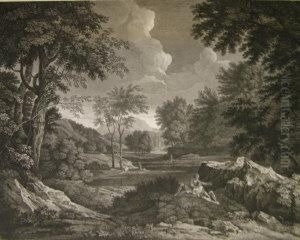Wilson Lowry Paintings
Wilson Lowry was a British engraver and occasional painter, known for his technical skill and contribution to the field of engraving during the late 18th and early 19th centuries. Born on November 24, 1762, in Whitehaven, Cumberland, England, he was the son of Strickland Lowry, a portrait painter, which likely influenced Lowry's early interest in the arts.
As a young man, Lowry demonstrated an aptitude for mechanical invention as well as art. He was apprenticed to an engraver in London, after which he began to work independently. Lowry quickly established himself as a skilled engraver, working on illustrations for scientific books, architectural works, and technical manuals. His reputation grew as he collaborated with notable scientists and engineers of the time, contributing to the dissemination of their work through his engravings.
Lowry was particularly noted for his ability to engrave on a variety of materials and for his use of a polygraphic machine, which allowed the simultaneous engraving of multiple plates. This innovation was significant in the mass production of images, a precursor to more modern printing techniques. Aside from his technical prowess, Lowry was also respected for his artistic ability, often translating complex scientific and architectural concepts into clear and accurate visual representations.
Throughout his career, Lowry remained engaged in the improvement of engraving techniques, and he was a fellow of the Royal Society. His engravings appeared in prestigious publications, such as the 'Encyclopaedia Britannica' and 'Philosophical Transactions of the Royal Society.' Despite facing personal challenges, including the loss of his first wife and some of his children, Lowry continued to advance in his field.
Wilson Lowry died on July 23, 1824, in London. His legacy is preserved in the quality and precision of his engravings, which remained influential in the fields of science and architecture. His works continue to be studied and appreciated for their clarity, accuracy, and aesthetic appeal, reflecting the intersection of art and science during the Industrial Revolution.
